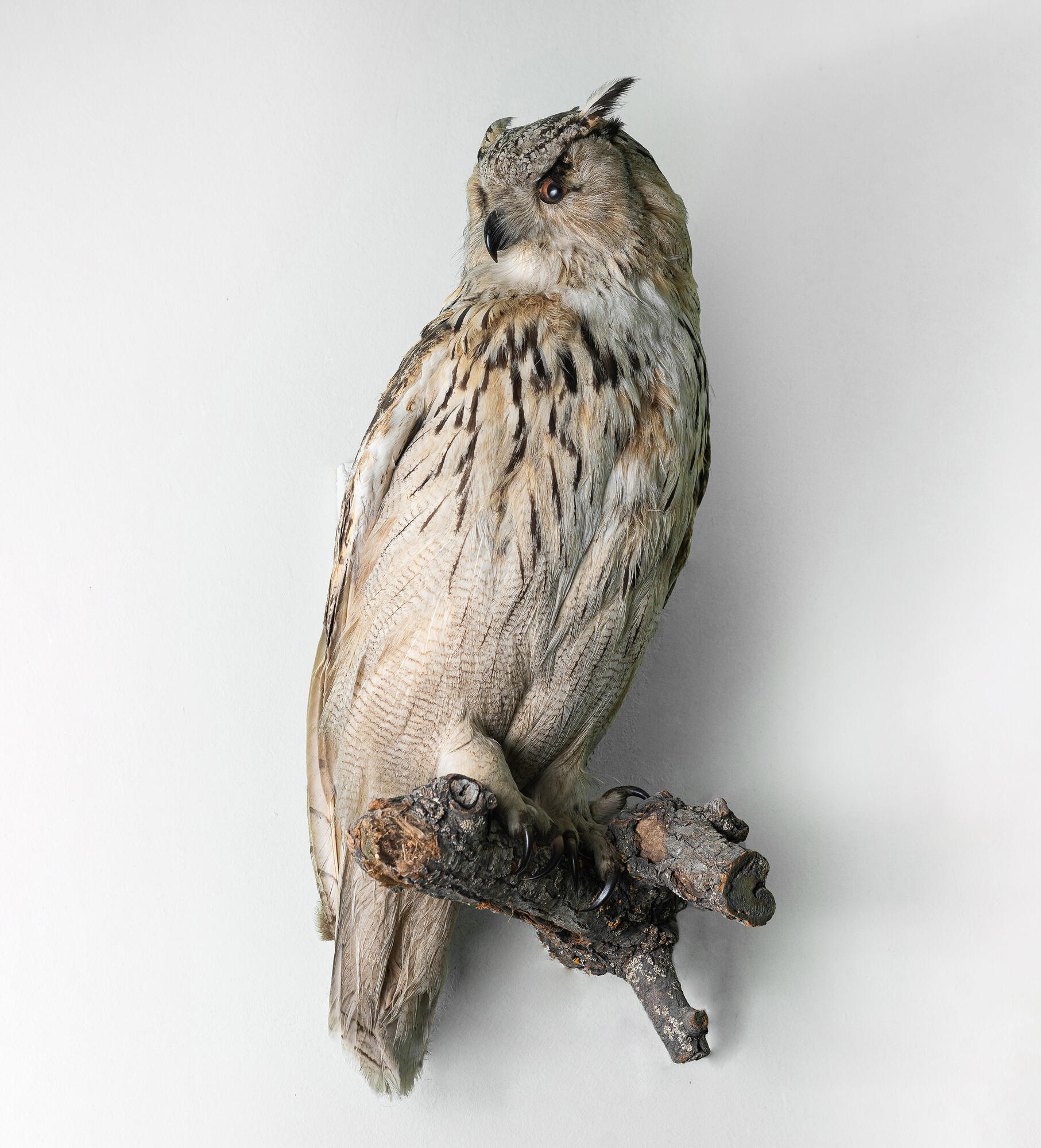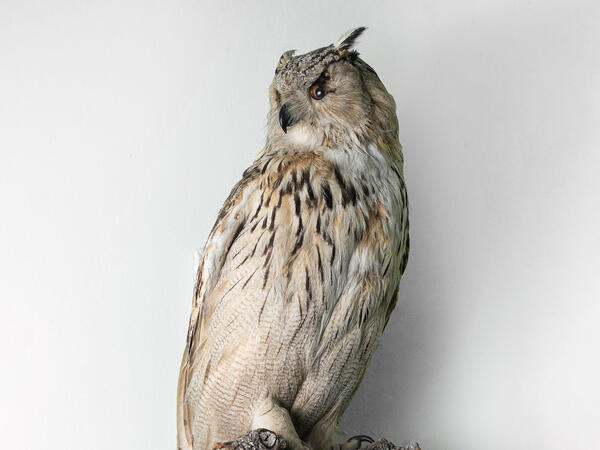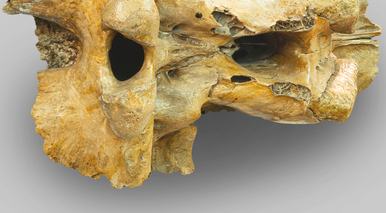In the exhibition hall of the inhabitants of the Volsk forest-steppe, there is a stuffed eagle owl — one of the largest representatives of the Owl family (Strigidae). Nowadays, the eagle owl is the only owl species listed in the Red Book of the Saratov region.
The size of the eagle owl is slightly inferior to the golden eagle but larger than the white owl. The length of an adult bird reaches 60–75 centimeters, and the wingspan is up to 190. Eagle-owl males weigh in the range of 2.1-2.7 kilograms, and females are noticeably more massive — 3-3.2 kilograms.
The eagle owl has a large head, large bright yellow eyes with a bit of orange, and a pronounced facial disc. It has a large barrel-shaped body and well-developed strong legs. The paws are equipped with long, sharp, and sharply curved claws.
The plumage of the eagle owl is loose and soft, it provides a silent flight and smooth gliding through the air. Due to the structure of the flight feathers from the side, the flight of the eagle owl seems light and slightly relaxed. Feathers are most often painted in light tones with numerous rusty-dark and black streaks, the main tone is creamy white with elements of an ocher hue. The top of the head and chest are the brightest.
The eagle owl is a bird of prey; it hunts hares, rodents, hedgehogs, crows, waterfowl, and chickens. It flies out for prey mainly at night, but in winter or on a cloudy day, it can hunt in the daytime. The owl looks out for the victim from a hill, and then flies up and glides over the terrain at a low altitude. Seeing the prey, the eagle owl swoops at it and fixes it tightly in its claws.
Small prey, like rodents and birds, is swallowed by the predator whole, larger prey is dismembered and eaten in pieces. The owl can return to the leftovers the next night. In the case of hedgehogs, the eagle owl removes the skin with needles before eating but sometimes can swallow it as it is. From time to time, it catches fish, amphibians, and reptiles.
With a good food supply, an eagle owl may stay in its territory for life. Usually, such areas do not exceed 80 square kilometers. The eagle owl carefully protects its territory from congeners, so birds in neighboring areas often form a lifelong pair.
The mating season for the eagle owl begins in February-March. The birds do not build nests: the female lays eggs in a small hole in the ground; as a shelter, it often uses low spruce branches, heaps of stones and fallen trunks, crevices, and gullies. There are only two or three eggs in the clutch. Only the female incubates them, and during this time the male takes care of it bringing the food.
Newly hatched owlets are small, only about 60 grams, they are blind and covered with thick ocher fluff. After four days, they open their eyes, and after another 20, they are covered with a colorful fuzz. Hungry owlets greet their parents with frequent chirping ‘uka… uka… uka’. At this time, they are already able to swallow a small mouse whole, and during feeding, they emit a loud ‘chiib’. At three months, the owlets become independent, although they will still beg for food from their parents for some time.
The size of the eagle owl is slightly inferior to the golden eagle but larger than the white owl. The length of an adult bird reaches 60–75 centimeters, and the wingspan is up to 190. Eagle-owl males weigh in the range of 2.1-2.7 kilograms, and females are noticeably more massive — 3-3.2 kilograms.
The eagle owl has a large head, large bright yellow eyes with a bit of orange, and a pronounced facial disc. It has a large barrel-shaped body and well-developed strong legs. The paws are equipped with long, sharp, and sharply curved claws.
The plumage of the eagle owl is loose and soft, it provides a silent flight and smooth gliding through the air. Due to the structure of the flight feathers from the side, the flight of the eagle owl seems light and slightly relaxed. Feathers are most often painted in light tones with numerous rusty-dark and black streaks, the main tone is creamy white with elements of an ocher hue. The top of the head and chest are the brightest.
The eagle owl is a bird of prey; it hunts hares, rodents, hedgehogs, crows, waterfowl, and chickens. It flies out for prey mainly at night, but in winter or on a cloudy day, it can hunt in the daytime. The owl looks out for the victim from a hill, and then flies up and glides over the terrain at a low altitude. Seeing the prey, the eagle owl swoops at it and fixes it tightly in its claws.
Small prey, like rodents and birds, is swallowed by the predator whole, larger prey is dismembered and eaten in pieces. The owl can return to the leftovers the next night. In the case of hedgehogs, the eagle owl removes the skin with needles before eating but sometimes can swallow it as it is. From time to time, it catches fish, amphibians, and reptiles.
With a good food supply, an eagle owl may stay in its territory for life. Usually, such areas do not exceed 80 square kilometers. The eagle owl carefully protects its territory from congeners, so birds in neighboring areas often form a lifelong pair.
The mating season for the eagle owl begins in February-March. The birds do not build nests: the female lays eggs in a small hole in the ground; as a shelter, it often uses low spruce branches, heaps of stones and fallen trunks, crevices, and gullies. There are only two or three eggs in the clutch. Only the female incubates them, and during this time the male takes care of it bringing the food.
Newly hatched owlets are small, only about 60 grams, they are blind and covered with thick ocher fluff. After four days, they open their eyes, and after another 20, they are covered with a colorful fuzz. Hungry owlets greet their parents with frequent chirping ‘uka… uka… uka’. At this time, they are already able to swallow a small mouse whole, and during feeding, they emit a loud ‘chiib’. At three months, the owlets become independent, although they will still beg for food from their parents for some time.



